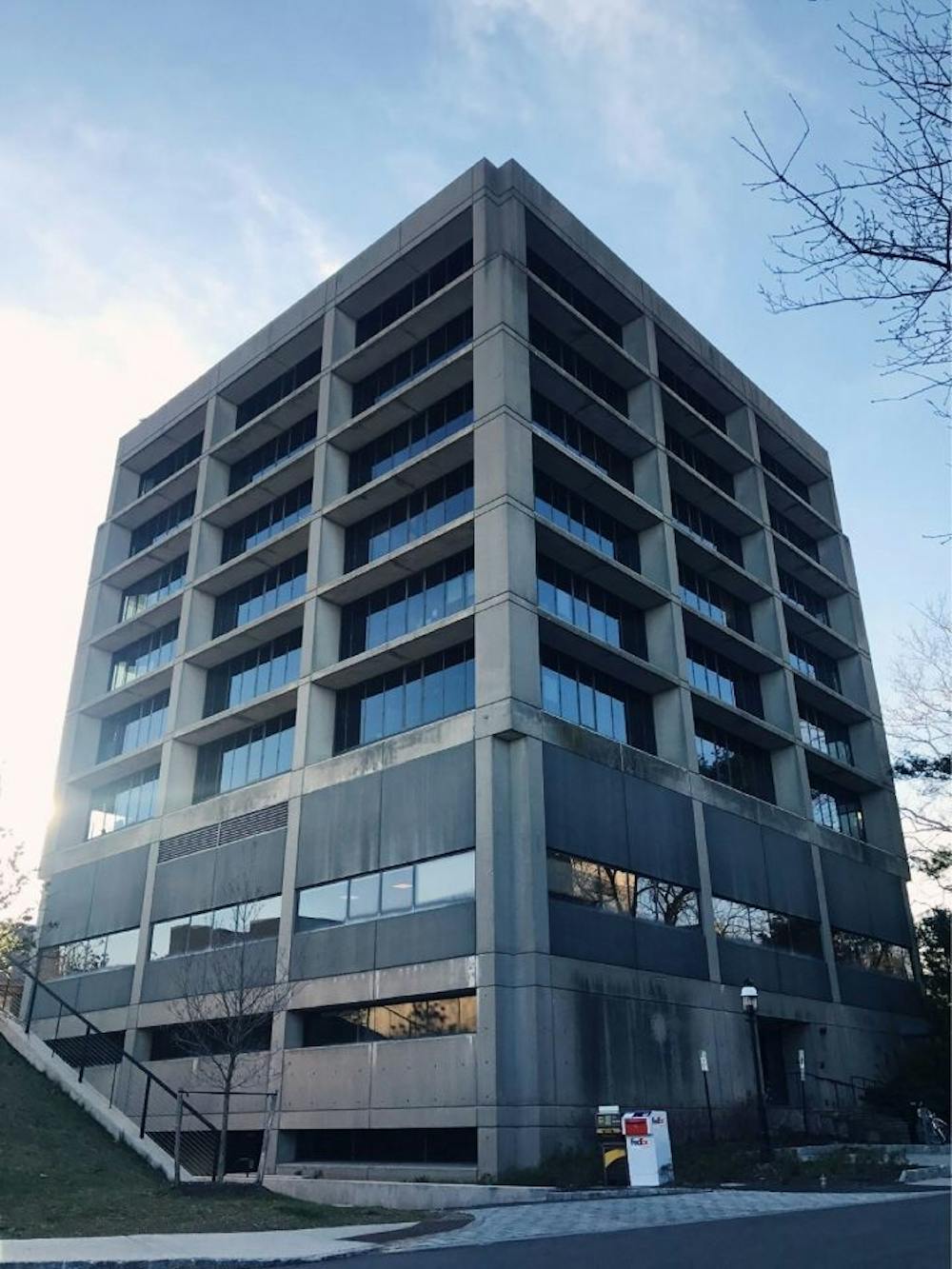It does not take a trained architectural eye to recognize the unabashedly modern design of New South Building. Built in 1965 and designed by the American architect Edward Larrabee Barnes, this administrative center in the southern part of campus presents an uncompromising façade of reflective glass and concrete, scorning all ornamentation. At seven stories tall, it stands as a veritable skyscraper on campus, surpassed only by Fine Hall and Cleveland Tower, located in the Graduate College. Overall, its form is dominated by one of the purest of geometric volumes, the cube.
Criticizing New South’s architecture from the outside is hardly uncommon. As many would point out, its design is devoid of creative formal subtleties that would add personality and character to an otherwise anonymous expression of International Style. The building’s concrete and glass materials, arranged rigidly in horizontal levels stacked on a vertical grid, give off a vaguely totalitarian aura, suggestive of Stalinist, Communist blocs. Now, and even more so when it was first built, the building refuses to respond to its surroundings, its black concrete disrupting the otherwise pleasant rolling landscape of grass and trees.
So much is hardly news to most students on campus. More interesting to me is one defense of the building’s architecture that I have heard: its view over campus, seen from its upper floors. From the glass-walled rooms of New South’s seventh floor, a viewer can see our entire southern campus laid out from west to east: Whitman residential dormitories are closest, then New Butler, then natural science laboratories, and beyond.
Last weekend, I wanted to investigate this much-lauded view. So, I spent the afternoon on the seventh floor of New South.
I must say, at first I was impressed. It was an experience of our campus’s built environment like none other. I could see tiny pedestrians moving around Wu Hall, automobiles driving down Elm Drive, and the entireties of three residential colleges. To me, this seemed at first a strange architectural paradox. How could I dislike a building from the outside so strongly, yet be impressed by its view from the inside?
Yet as the afternoon progressed, and I spent more and more time glancing out from this viewpoint, I began to feel uneasy. For a while I could not articulate why, but eventually it dawned on me.
This was not how our campus was meant to be experienced.
In the nearly three years that I’ve been at Princeton, the aspect of our campus I’ve come to admire most is the centrality it gives to the pedestrian experience. Unlike many college campuses, which perhaps display impressive individual buildings but neglect how people travel between them, Princeton’s campus landscape makes even a casual stroll between classes an enjoyable experience. This is especially true of its southern section.
On a sunny day, a stroll down Tilghman Walk brings a wonderful sense of peace and contentment. Here, as one gracefully treads the line between student dormitories to the left and the grassy expanse of Poe Field to the right, one feels both city and nature simultaneously, a truly unique experience.
A journey eastward from Wu Hall to Fine Hall on an autumn afternoon brings profound balance. This is brought about by a remarkably perspectival view that arises from the collinearities of Thomas and Schultz Laboratories, the stone-paved Goheen Walk, and evenly spaced lamp posts. It is truly the “Ideal City,” as expressed by the Italian Renaissance architect Leon Battista Alberti, manifested right before our eyes.
Walking down from Frist Campus Center, a pedestrian’s descent southward is gracefully mediated by a series of winding pathways and stone stairways. Along the way, one is redirected perpendicularly to the intended direction of travel to walk through an allée, formed by the evenly spaced trees.
In sum, our campus’s built environment is most meaningfully experienced in a particular way: from the ground, where journey is highlighted as much as destination and where one appreciates its beauties at the scale of an individual human being.

This, I realized, is why the view from New South was so exceedingly unsettling. From this viewpoint, as the campus lay prostrate before my eyes, all those personal, intimate experiences were irreparably destroyed.
Instead of subtle design surprises greeting the pedestrian who rounds a corner, here everything was presented at once. Looking on those walkways I had come to love from the standpoint of a pedestrian, at a gradual pace that encouraged me to appreciate their subtleties, I was disturbed by how quickly the eye could move from start to finish. Our campus, best experienced in a dynamic, deeply intimate fashion, was here presented as if on a television screen.
In fact, from this angle the campus looked not well-integrated, but surprisingly disjointed. Instead of the usual synergy between its diverse architectural styles, the buildings instead appeared haphazardly placed, not fitting a previously thought-out plan as the Modernist philosophy underlying New South itself might prescribe.
Over the past decade, the University has quite obviously attempted to improve the interior of New South, to little avail. Installing brightly-colored furniture such as lime green stools and tangerine orange chairs, as well as blanketing the walls with a nearly fluorescent yellow paint, hardly injects genuine vivacity into the building’s design. Instead, the juxtaposition of these vibrant hues with the building’s colorless exterior merely highlights the latter’s dreariness. Importantly, the only renovation that could put an end to the hazard that its startlingly expansive view poses to the experience of our beautiful campus, would be to cover with some opaque material its whole-wall windows entirely. Something tells me this is not an option. While New South is likely here to stay, we should learn from its mistakes. In the future, as our campus expands southward, we should do our best to encourage the University to eschew such high-rise designs.
Gabriel Lipkowitz is a junior in molecular biology from Charlottesville, Va. He can be reached at gel@princeton.edu.








